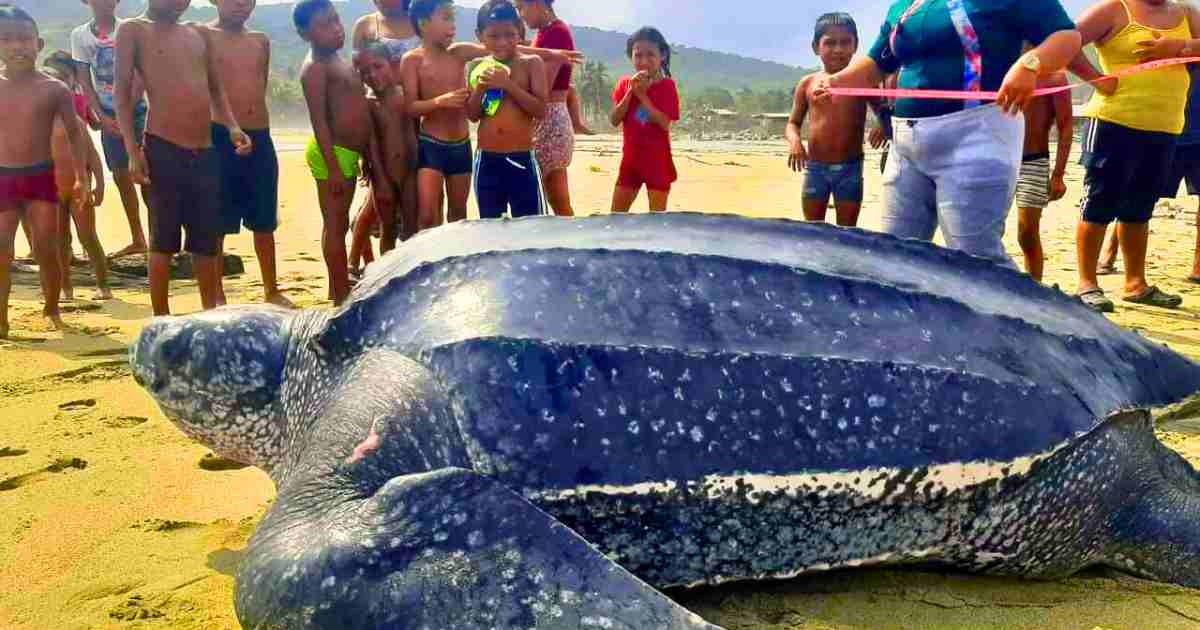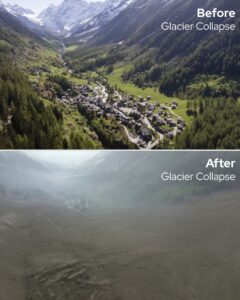Every so often, nature reminds us just how ancient and extraordinary it can be. On a quiet beach somewhere along the coastline, a breathtaking wildlife moment unfolded when a massive leatherback turtle — the largest turtle species on Earth — slowly emerged from the sea.
Weighing nearly 2,000 pounds and stretching close to seven feet long, this gentle giant offered a rare glimpse into a world few ever witness up close.
The Incredible Emergence
The footage, captured by a tourist, shows the enormous turtle rising from the rolling surf and making her way across the golden sand. Each movement is deliberate, powerful, and slow — her massive flippers sweeping arcs in the soft beach as the tide recedes behind her.
For a few minutes, the crowd of onlookers stays completely silent. Then comes the whispering awe — the kind of reverent hush only true wildlife encounters inspire. Cameras click, waves crash, and the turtle, seemingly unfazed by the audience, pauses midway up the beach to rest.

The moment feels ancient — a scene that could have played out a hundred, or even a thousand, years ago.
Also Read: Man Loses 360 Pounds Naturally — Internet Rallies to Support His Next Step
A Giant Among Animals
Leatherback turtles are the heavyweights of the turtle world. Unlike their hard-shelled relatives, they have soft, rubbery carapaces covered with tough skin and oily flesh. This flexible armor allows them to dive deeper than any other turtle — over 4,000 feet into the ocean’s depths — chasing jellyfish, their favorite food.
Their size is staggering. Adult leatherbacks often weigh between 700 and 2,000 pounds. The largest ever recorded measured more than 10 feet long and tipped the scales at over a ton. Despite their immense bulk, they move through water with the grace of a bird in flight, propelled by strong, wing-like flippers that can span more than seven feet.
Seeing one of these titans on land is a rare privilege. They spend most of their lives at sea, coming ashore only to nest.

A Rest Between Worlds
The turtle in the video appears to have come ashore to rest or possibly to scout a nesting site. As she hauls herself higher onto the beach, you can almost sense the exhaustion from her long journey. Leatherbacks migrate thousands of miles across the oceans each year — crossing entire hemispheres between feeding and breeding grounds.
After a few moments of stillness, the turtle begins her slow return. The crowd watches as she waits for the next wave to reach her belly, then uses the surge to glide back into her blue domain. Her dark shell glistens in the sun one final time before she disappears beneath the water.
Full Story: Science Confirms Kelly Brook’s Perfect Body — But the Real Message Is Bigger Than Beauty
The Long Road of Survival
It’s easy to forget how fragile this species has become. Leatherback turtles have roamed the planet for more than 100 million years — surviving the extinction of dinosaurs, ice ages, and shifting continents. Yet today, they face their toughest challenge: humans.
Their eggs are often stolen from beaches, their young caught in fishing nets, and their feeding grounds polluted by plastic waste that resembles jellyfish. The same ocean that sustains them is slowly turning against them.
Conservationists estimate that only one in a thousand leatherback hatchlings will reach adulthood. It takes between 15 and 20 years for a baby turtle to mature — an extraordinary investment of time and luck in a dangerous world.
Still, they endure. Every nesting season, females climb out of the water and dig deep nests in the sand to lay up to 100 eggs. When the babies hatch weeks later, they make a frantic dash toward the moonlit sea — tiny silhouettes racing against predators and waves alike. Those that survive vanish into the deep, not to return for decades.
The Ancient Wisdom of the Ocean
Watching a creature like this leatherback emerge from the water feels like witnessing prehistory alive. These animals are living fossils, carrying within them a story older than humanity itself.
Their eyes, calm and unreadable, seem to hold the rhythm of the tides — the knowledge of endless migrations and silent depths. For those who stood on that beach, it wasn’t just a sighting; it was communion with something timeless.
A Call to Protect
Moments like this remind us why wildlife rescue and ocean conservation matter. Protecting creatures like the leatherback turtle isn’t only about saving a species — it’s about keeping the planet’s balance intact.
Every leatherback plays a vital role in the ecosystem. By feeding on jellyfish, they help control populations that might otherwise overwhelm fish stocks. Their nesting habits aerate beaches, and even their eggs — those that don’t hatch — nourish coastal vegetation.
The loss of these turtles would ripple far beyond the shoreline.
Lessons From the Sand
As the tide reclaimed the massive turtle that day, those who watched understood they’d witnessed more than a rare event. They’d seen a miracle of endurance — proof that even in a world filled with noise and speed, some parts of nature still move at their own eternal pace.
It’s humbling to think that the same beaches we walk today once held the footsteps of creatures who predate human civilization. And yet, our choices now determine whether they continue to walk them tomorrow.
If the turtle in that video could speak, perhaps she’d tell us to slow down. To breathe. To remember that we share this world, not own it.
A Closing Thought
When she finally slipped back into the waves, the giant leatherback didn’t look back. She didn’t need to. The ocean was waiting — her true home, vast and forgiving.
For the lucky few who saw her, the moment will last a lifetime. For the rest of us, it’s a reminder: the world is still full of wonders, but only if we care enough to protect them.
Because every time a turtle like her surfaces from the deep, it’s not just a return to shore — it’s wildlife whispering that there’s still hope beneath the waves.


